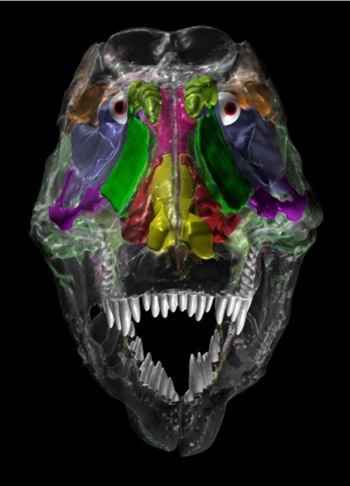|
 Dinosaur air
heads. The role of complicated sinuses and convoluted airways.
Air spaces such as the airway and sinuses comprise a
neglected anatomical system. CT scanning and advanced 3D
computer visualization provided the most complete view ever of
the air spaces in two groups of dinosaurs and their modern
relatives (birds and crocodilians), with a mammal of parochial
interest (humans) thrown in for comparison. Modern alligators
and ostriches both show great diversity in air sinuses,
revealing that the complex air spaces of dinosaurs were part of
their archosaurian heritage. All of the air spaces were modeled
in the predatory theropod dinosaurs Majungasaurus and
Tyrannosaurus, revealing in both a simple arcing airway,
large olfactory regions, and lots of sinuses. But the major
finding was just how much of the head was occupied by air. The
brain cavity was tiny in comparison. An outcome of digitally
reconstructing all the head tissues was that head mass could be
calculated, allowing an assessment of potential weight savings
due to the sinuses. The fully fleshed-out head of
Majungasaurus weighed 32 kg (70 lbs), whereas that of T.
rex weighed an enormous 515 kg (over 1100 lbs, as much as
five or six adult men). Having all the sinuses saved about 8% of
head mass but as much as 18% of skull mass, which is significant
given how metabolically expensive bone is to maintain. The
skulls of armored ankylosaurian dinosaurs also were studied,
particularly those of Panoplosaurus and Euoplocephalus.
Although it previously had been widely thought that their snouts
were riddled with sinuses, the new, surprising results were
that, instead of sinuses, their snouts housed a long convoluted
nasal airway. This “crazy-straw” airway ran close to large blood
vessels and so may have provided a physiological mechanism for
dealing with heat. Likewise, the complicated airway would have
acted as a vocal resonator, perhaps allowing for species- or
even individual specific vocalization. Clearly, the spaces that
make up these dinosaurian “air heads” represent a new, largely
untapped, window into dinosaur function and behavior. Dinosaur air
heads. The role of complicated sinuses and convoluted airways.
Air spaces such as the airway and sinuses comprise a
neglected anatomical system. CT scanning and advanced 3D
computer visualization provided the most complete view ever of
the air spaces in two groups of dinosaurs and their modern
relatives (birds and crocodilians), with a mammal of parochial
interest (humans) thrown in for comparison. Modern alligators
and ostriches both show great diversity in air sinuses,
revealing that the complex air spaces of dinosaurs were part of
their archosaurian heritage. All of the air spaces were modeled
in the predatory theropod dinosaurs Majungasaurus and
Tyrannosaurus, revealing in both a simple arcing airway,
large olfactory regions, and lots of sinuses. But the major
finding was just how much of the head was occupied by air. The
brain cavity was tiny in comparison. An outcome of digitally
reconstructing all the head tissues was that head mass could be
calculated, allowing an assessment of potential weight savings
due to the sinuses. The fully fleshed-out head of
Majungasaurus weighed 32 kg (70 lbs), whereas that of T.
rex weighed an enormous 515 kg (over 1100 lbs, as much as
five or six adult men). Having all the sinuses saved about 8% of
head mass but as much as 18% of skull mass, which is significant
given how metabolically expensive bone is to maintain. The
skulls of armored ankylosaurian dinosaurs also were studied,
particularly those of Panoplosaurus and Euoplocephalus.
Although it previously had been widely thought that their snouts
were riddled with sinuses, the new, surprising results were
that, instead of sinuses, their snouts housed a long convoluted
nasal airway. This “crazy-straw” airway ran close to large blood
vessels and so may have provided a physiological mechanism for
dealing with heat. Likewise, the complicated airway would have
acted as a vocal resonator, perhaps allowing for species- or
even individual specific vocalization. Clearly, the spaces that
make up these dinosaurian “air heads” represent a new, largely
untapped, window into dinosaur function and behavior.
|